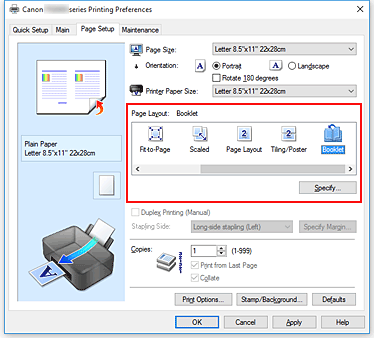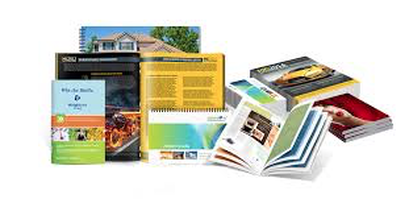The Necessary Guide to Understanding Brochure Printing Options and Techniques
The process of brochure printing includes multiple considerations that can considerably influence the final product. From picking the ideal format and size to recognizing the nuances of binding methods, each choice plays a crucial role. In addition, variables such as paper supply and printing techniques more influence the performance of the brochure. As one browses these options, it ends up being necessary to realize how they interconnect and what that suggests for the general end result.
Comprehending Pamphlet Sizes and layouts
When taking into consideration brochure printing, comprehending the various styles and sizes offered is necessary for accomplishing the wanted presentation. Booklets can be created in countless layouts, consisting of saddle-stitched, spiral-bound, and perfect-bound, each offering unique benefits. Usual dimensions vary from common letter (8.5 x 11 inches) to smaller options like A5 (5.8 x 8.3 inches), enabling versatility based on content and target audience.Selecting the appropriate dimension can affect both the design and viewers engagement. Bigger sizes might match visually driven material, while smaller formats might be much more mobile and easy to use. Additionally, the number of web pages influences the choice of binding method, as thicker brochures might call for tougher bindings. Eventually, comprehending these aspects permits a much more customized method, guaranteeing that the last item lines up with the desired message and aesthetic, enhancing the total performance of the communication.
Selecting the Right Paper Supply

Binding Approaches: Considerations and options
When it involves binding techniques for booklets, numerous choices are readily available, each with distinct benefits. Saddle stitch binding supplies an affordable option for thinner pamphlets, while ideal binding techniques provide an even more refined try to find thicker magazines. Wire-O binding stands apart for its longevity and convenience of usage, making it excellent for documents that require versatility.
Saddle Stitch Binding
Saddle stitch binding uses a cost-effective and functional service for assembling brochures, making it a popular choice among authors and organizations. This binding method includes folding sheets of paper in half and stapling them along the fold line, developing a organized and cool look. Generally suitable for brochures with a reduced page matter, saddle sewing is suitable for publications, brochures, and instructional products. The simplicity of this technique enables for quick production and is typically favored for marketing items or brief runs. It is necessary to keep in mind that saddle stitch binding may not be appropriate for thicker pamphlets, as the spine might not hold up under raised weight. Overall, it continues to be a reputable alternative for numerous printing tasks.
Perfect Binding Techniques
Perfect binding is a commonly used technique that gives a professional and refined surface to booklets and magazines. This technique includes gluing the pages together at the spine utilizing a strong adhesive, permitting a tidy side and the capability to hold a larger variety of pages contrasted to saddle stitching. Perfect binding is specifically ideal for thicker brochures, such as catalogs and annual reports, where a strong, level back is preferred. Furthermore, it offers the alternative for a published cover that can be created to improve visual appeal. However, considerations such as page matter, paper weight, and the planned use the pamphlet ought to be thought about, as they can influence sturdiness and total quality.
Wire-O Binding Alternatives
Wire-O binding, understood for its sturdiness and flexibility, uses a superb alternative for booklets that need simple web page turning and a professional appearance. This binding approach employs a collection of steel loops that hold web pages safely, enabling them to exist level when open. It is particularly ideal for manuals, catalogs, and presentations as a result of its durable nature. Wire-O binding is offered in different shades and diameters, fitting different page counts and thicknesses. Furthermore, it allows the inclusion of tabs and covers, enhancing the booklet's total visual. Factors to consider for Wire-O binding consist of the option of wire shade, the dimension of the loopholes, and the degree of modification wanted, every one of which can greatly influence the end product's look and performance.
Digital vs. Offset Printing: Which Is Best for You?
When picking a printing technique for pamphlets, understanding the distinctions between electronic and offset printing is crucial. Digital printing uses contemporary innovation to produce top quality prints quickly and cost effectively, making it ideal for short runs or jobs calling for fast turn-around times. It enables modification, supplying the ability to publish on-demand with marginal waste.In comparison, counter printing is a traditional technique that masters producing big quantities with consistent high quality. It entails moving ink from a plate to a rubber covering, then to the paper, which results in precise information and vibrant colors. Nevertheless, balance out printing usually calls for longer configuration times and is more cost-effective for bigger volumes.Ultimately, the choice between digital and offset printing depends upon project needs, spending plan, and preferred amount. For tiny, time-sensitive projects, electronic could be the very best option, while countered may be more suitable for larger, high-grade productions.

Designing Your Brochure: Tips and Finest Practices
When creating a brochure, careful attention to format, typeface selection, and color use can considerably boost its efficiency. A well-structured format guides the visitor's eye, while appropriate font styles assure readability and communicate the wanted tone. Furthermore, efficient usage of color can stimulate feelings and highlight vital details, making the overall style much more impactful.
Choosing the Right Design
Exactly how can one properly choose the right format for a brochure? It is necessary to assess the booklet's objective and target audience. A tidy, organized design improves readability and involvement. Utilizing a grid system can help in straightening aspects consistently, producing an expert appearance. Furthermore, integrating aesthetic power structure through differing dimensions and placements of pictures and message can assist the reader's eye and highlight key info. It is likewise essential to leave adequate white space, which stops overcrowding and permits for better focus. Lastly, examining various formats through mock-ups can give insight right into exactly how the design carries out in real-world situations, making sure that the last item fulfills both practical and aesthetic requirements.
Picking Suitable Typefaces
An why not check here appropriate font style can significantly enhance the general style of a booklet, matching the layout and enhancing the web content's message. The option of fonts should think about readability, particularly for body text, as it ensures the info is accessible to all readers. Sans-serif typefaces are frequently preferred for electronic styles, while serif font styles can provide a conventional feel in printed products. It's a good idea to restrict font selections to 2 or 3 to keep aesthetic coherence. In addition, font dimension plays a crucial duty; headings ought to be distinctive but not frustrating, while body text must fit for great site reading. When selecting fonts, placement with the pamphlet's style and target market is vital for reliable communication and aesthetic charm.
Effective Use Color
Shade acts as an effective tool in brochure design, assisting and forming assumptions visitor emotions. It can evoke sensations of peace, exhilaration, or trust fund, relying on the hues chosen. Designers need to consider shade concept principles, making sure that the chosen combination straightens with the booklet's message and target audience. Using cozy colors like red and orange can develop urgency, while cooler tones like environment-friendly and blue foster tranquility.Additionally, contrast plays a crucial role; complementary colors can boost readability and aesthetic allure. Uniformity in color usage throughout pages further reinforces brand identity and communication. Inevitably, reliable color application not just catches focus yet additionally enhances the brochure's function, making it a necessary aspect of successful design.
Completing Touches: Coatings and Unique Results
While many consider the material and format of a brochure the most important components, the completing touches, such as layers and special impacts, play a vital duty in improving its overall allure. Coatings can give defense and longevity, making sure that the brochure withstands deterioration. Matte finishes provide a sophisticated, non-reflective surface area, while glossy finishes can make shades show up even more attractive and vibrant. Special effects, like embossing or aluminum foil stamping, include a responsive dimension that can produce an unforgettable impression. These methods can highlight certain locations, drawing interest to essential info or developing visual interest. Furthermore, UV covering can provide a high-shine surface that elevates the general look.Together, these ending up touches not only enhance the booklet's visual yet likewise connect professionalism and attention to information, inevitably leaving a long lasting influence on the visitor.
Price Factors To Consider for Brochure Printing
Understanding the different cost factors to consider for brochure printing is vital for organizations and businesses aiming to enhance their budgets. Key aspects affecting prices include the choice of paper, ink, and binding techniques. Better materials, such as exceptional paper or specialized inks, typically increase the overall cost. Additionally, the size and page count of the brochure play a substantial duty; bigger continue reading this booklets call for even more resources and time to produce.Another vital factor to consider is the printing technique, whether electronic or balanced out, as each has its own prices framework and viability for various quantities. Services need to also consider layout prices, which can vary based on intricacy and the usage of professional solutions. Inevitably, delivery and handling charges can include in the total amount, specifically for big orders. By reviewing these elements, companies can make educated choices that line up with their monetary capacities while attaining the preferred high quality in their printed products.
Regularly Asked Inquiries
What Are the Ecological Effects of Booklet Printing?
The ecological effects of pamphlet printing include deforestation from paper production, carbon discharges from transport, and waste generation from disposed of products - Booklet Printing. Lasting methods, such as using recycled paper and green inks, can mitigate these impacts
Exactly How Can I Ensure Color Precision in My Brochure?
To ensure color accuracy in a pamphlet, one need to make use of adjusted screens, employ specialist color accounts, conduct test prints, and pick top notch printing solutions that use color matching and proofing choices for ideal outcomes.
What Is the Common Turnaround Time for Brochure Printing?
The typical turnaround time for brochure printing varies relying on the intricacy and quantity - Booklet Printing. Typically, it varies from a couple of days to 2 weeks, influenced by elements such as printing approaches and finishing demands
Are There Minimum Order Quantities for Booklet Printing?

Can I Publish Pamphlets in Multiple Languages?
Publishing brochures in numerous languages is possible. Lots of printing services use alternatives for bilingual or multilingual formats, permitting for efficient communication. Cautious planning warranties that develop components suit various languages without jeopardizing readability or aesthetic appeals. Furthermore, variables such as paper supply and printing techniques more affect the performance of the pamphlet. When thinking about pamphlet printing, comprehending the various formats and sizes offered is essential for achieving the desired discussion. When choosing a printing method for pamphlets, comprehending the differences in between electronic and balance out printing is essential. Additionally, the dimension and page matter of the brochure play a considerable duty; bigger booklets need more resources and time to produce.Another essential factor to consider is the printing method, whether digital or balanced out, as each has its own rates structure and suitability for different amounts. The environmental effects of pamphlet printing include deforestation from paper manufacturing, carbon discharges from transport, and waste generation from discarded products.